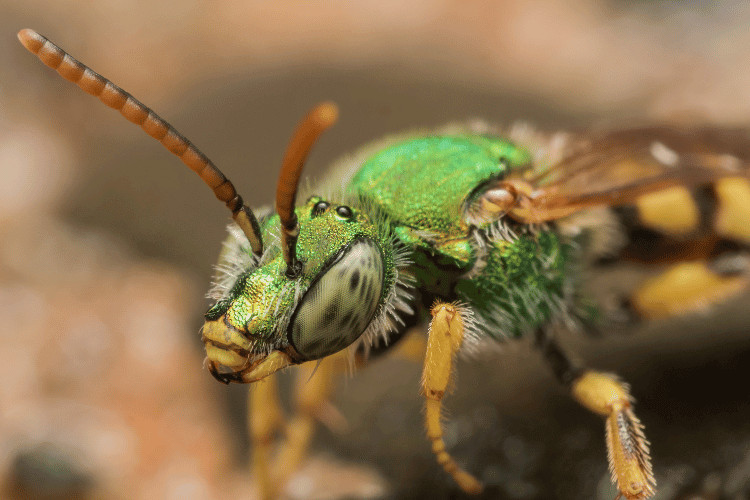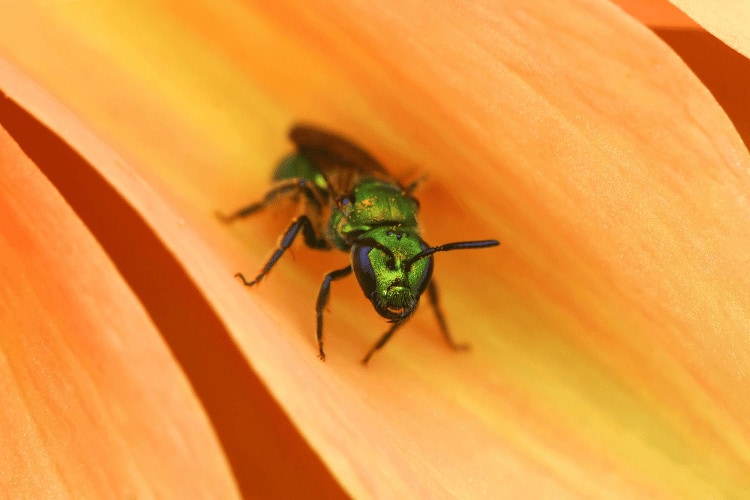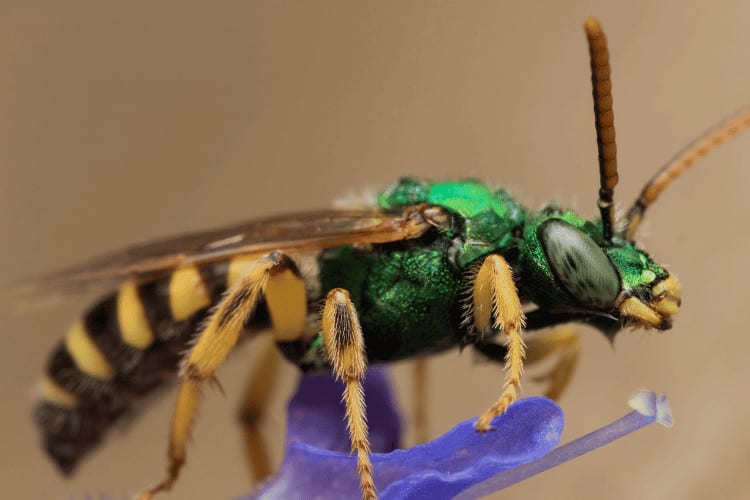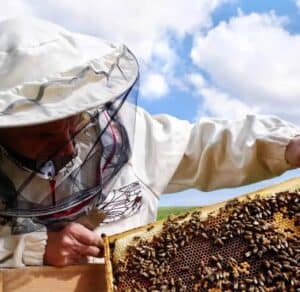Green Sweat Bees: A Beautiful and Important Pollinator
Green sweat bees are small, metallic green bees that are found in North America. They’re attracted to open, sunny areas with flowers and are important pollinators. Green sweat bees are solitary bees, meaning that they do not live in hives.
Unfortunately, green sweat bees are facing a number of threats, including habitat loss, pesticide use, and climate change. Habitat loss is a major threat to green sweat bees because it reduces the availability of suitable nesting sites.
Keep reading to know more about these fascinating creatures!
Description and Characteristics of Green Sweat Bees

Green sweat bees, also known as Augochlora pura, are native to North America and can be found in most of the eastern United States and southern Canada.
Green sweat bees are small, about 1/4 to 1/3 of an inch long. They have a brilliant metallic green body, with some species having copper or blue overtones.
They’re sometimes called “flying emeralds” because of their beautiful green color! Their hind legs are also green, with brown tarsi (feet). Their antennae are black, and if you look closely, you’d notice that their wings are clear.
Interestingly, these green buzzers are attracted to perspiration, which they lick for moisture and salts. They are solitary bees, meaning that each female builds her own nest and raises her own young. They’re not aggressive and will only sting if they feel threatened.
If you see a green sweat bee, don’t be afraid! They are harmless creatures that are just looking for a little moisture and salt. Enjoy watching them as they buzz around your flowers!
What Is a Green Sweat Bees Purpose?
I was once sitting in my garden, tending to my beehive on a hot summer day, when I felt a small bee land on my arm. I looked down and saw a beautiful green sweat bee. It was so shiny that it looked like it was made of emeralds!
The bee stayed on my arm for a few minutes, licking the perspiration from my skin. Then, it flew away to find another flower to pollinate. I was glad to have the company of the green sweat bee. It was a reminder of the importance of these small creatures in our ecosystem.
Green sweat bees are important pollinators. They help to pollinate a variety of flowers, including fruits, vegetables, and wildflowers. Without green sweat bees, we would have less food to eat and our environment would be less diverse.
Green Sweat Bees Habitat and Foraging Preferences
Green sweat bees are native to North America. They can be found in most of the eastern United States and southern Canada.
Green sweat bees were first discovered in the early 1800s. They were named for their metallic green color, which is caused by a pigment called chrysomelanin. This pigment is also found in some other insects, such as beetles and butterflies.
Green sweat bees forage in a variety of habitats, including:
- Open fields
- Meadows
- Gardens
- Forests
- Along roadsides
- In parks
They have short tongues, so they visit mainly flat flowers with open blossoms, such as:
- Clover
- Dandelions
- Asters
- Goldenrod
- Sunflowers
- Sunflowers
- Lilacs
- Mint
- Wildflowers
Green sweat bees are a generalist or common pollinators, meaning, that they’ll visit a wide variety of flowers. It makes this bee species effective as wild pollinators for many types of plants.
They’re also attracted to perspiration, or human sweat, which they lick for moisture and salts. This is why they are sometimes called “sweat bees.”
Where Can You Find Green Sweat Bees?
Green sweat bees are native to North America. They can be found in most of the eastern United States and southern Canada. Their range extends from Quebec to Florida and from Minnesota to Texas.
Green sweat bees are most commonly found in open fields, meadows, gardens, and forests. They are attracted to flowers with open blossoms, such as clover, dandelions, and asters.
Here are some specific places where you might find green sweat bees:
- In your garden, if you plant native flowers that they like.
- Along roadsides, where there are wildflowers.
- In parks, where there are gardens and flower beds.
- In forests, where there are open areas with flowers.
- Near bodies of water, where there are flowers and insects.
If you’re looking for green sweat bees, the best time to look is late spring to late summer, when they’re most active. You can also attract them to your yard by planting native flowers and avoiding using pesticides.
Green Sweat Bees Life Cycle, Mating, and Nesting

Green sweat bees have a complete metamorphosis, which means they go through four stages of life: egg, larva, pupa, and adult.
Life Cycle
- Egg: The female green sweat bee will lay her eggs in individual cells in a nest. She will provision each cell with nectar and pollen, which will serve as food for the developing larva.
- Larva: The larva will hatch from the egg and begin to feed on the nectar and pollen provided by its mother.
- Pupa: After the larva has finished growing, it will pupate. The pupa is a resting stage during which the larva transforms into an adult bee.
- Adult: A fully-grown adult bee will finally emerge from the pupa.
Mating
Green sweat bees mate in the spring. The males will search for females and will follow them until they are ready to mate. The male will then grasp the female with his forelegs and will fertilize her eggs.
Nesting
Green sweat bees are solitary bees, meaning that each female builds her own nest and raises her own young.
The female will dig a tunnel in the ground and will line it with mud or sand. She will then lay her eggs in individual cells in the nest and will provision each cell with nectar and pollen. The female will seal the cells with mud or sand and will leave them to hatch.
The larvae will feed on the nectar and pollen and will pupate in the cells. The adult bees will emerge from the cells in the spring.
Importance of Green Sweat Bees in Ecosystems and Agriculture
Green sweat bees are essential pollinators in ecosystems and agriculture. They help to pollinate a variety of plants, including fruits, vegetables, and wildflowers.
Green sweat bees are particularly native pollinators. Native plants are essential for maintaining healthy ecosystems, and they provide food and shelter for a variety of wildlife.
Green sweat bees are also important for the pollination of commercial crops. For example, green sweat bees help to pollinate blueberries, tomatoes, and clover.
In addition to the above, green sweat bees also play a role in regulating pest populations. This is important for maintaining healthy ecosystems and ensuring the production of food.
Common Questions About Green Sweat Bees
What Do Green Sweat Bees Eat?
Green sweat bees are nectarivorous, meaning that they eat nectar and pollen. They collect nectar from flowers and use it for energy.
In addition to nectar and pollen, green sweat bees may also eat honeydew, which is a sugary substance produced by aphids and other insects. Honeydew is a good source of carbohydrates for green sweat bees.
These little fellows don’t eat meat or other insects, and they’re generally harmless to humans and pets.
Are Green Sweat Bees Dangerous?
Green sweat bees are not generally dangerous to humans. They are solitary bees, which means that they do not live in hives and they are not aggressive. They will only sting if they feel threatened.
If you see a green sweat bee, it’s best to leave it alone. Do not swat at it or try to pick it up. If the bee lands on you, gently brush it away.
If a green sweat bee does sting you, the pain is usually mild and goes away within a few hours. You can apply a cold compress to the area to help reduce the swelling and pain. However, if you’re allergic to bee stings, you should seek medical attention immediately.
As beekeepers, here’s what we recommend to avoid getting stung by a green sweat bee:
- Wear long sleeves and pants when you’re gardening or working outdoors.
- Avoid wearing bright colors, as this can attract bees.
- Do not swat at bees or try to pick them up.
- If you see a bee on you, gently brush it away.
- If you’re allergic to bee stings, carry an EpiPen with you at all times.
What Size Are Green Sweat Bees?
Green sweat bees are relatively small creatures. They’re not as big as honeybees, but they’re still a significant part of the ecosystem. They’re about 1/4 to 1/3 of an inch long.
Here’s a table that shows the average size of green sweat bees in different parts of the world:
| Region | Length (in inches) |
| Eastern United States | 0.25-0.3 |
| Southern Canada | 0.25-0.35 |
| Western United States | 0.15-0.2 |
| Mexico | 0.2-0.25 |
How to Identify Green Sweat Bees?

Green sweat bees are small, about 1/4 to 1/3 of an inch long. They have a brilliant metallic green body, with some species having copper or blue overtones. Their legs are also green, with brown tarsi (feet). Their antennae are black. Their wings are clear.
Here are some other things to look for when identifying green sweat bees:
- The shape of the abdomen. Green sweat bees have a slender, oval abdomen that is slightly wider in the middle. This is in contrast to the more rounded abdomen of honeybees.
- The color of the legs. The legs of green sweat bees are typically green, but they may have a brown or black stripe on the tarsi. This is in contrast to the mostly brown legs of honeybees.
- The color of the antennae. The antennae of green sweat bees are typically black, but they may have a brown or yellow tip. This is in contrast to the mostly black antennae of honeybees.
- The color of the wings. The wings of green sweat bees are clear, but they may have a faint blue or green tint. This is in contrast to the mostly yellow wings of honeybees.
In addition to these physical characteristics, green sweat bees can also be identified by their behavior. Green sweat bees are solitary bees, meaning that they don’t live in hives.
They are also not aggressive and will only sting if they feel threatened. Honeybees, on the other hand, are social insects that live in hives. They are also more aggressive and will sting more readily if they feel threatened.
How to Attract Green Sweat Bees?
Here are some tips on how to attract green sweat bees to your garden:
- Plant native flowers. Green sweat bees are attracted to a variety of flowers, but they prefer native flowers. Native flowers are adapted to the local climate and environment, and they provide food and shelter for green sweat bees.
- Avoid using pesticides. Pesticides can kill green sweat bees and other pollinators. Use them carefully and sparingly.
- Leave some areas of your yard unmowed. Green sweat bees need places to nest and forage. Leaving some areas of your yard unmowed will provide them with this habitat.
- Build a bee hotel. A bee hotel is a great way to provide green sweat bees with a place to nest. You can buy a bee hotel online or make your own.
- Place your flowers in sunny spots. Green sweat bees prefer to forage in sunny areas.
- Water your flowers regularly. Green sweat bees need water to survive.
- Keep your flowers free of weeds. Weeds can compete with flowers for food and water.
- Be patient. It may take some time to attract green sweat bees to your garden. But once they do, you will enjoy watching them pollinate your flowers and contribute to a healthy ecosystem.
Conclusion
Green sweat bees and honey bees can coexist peacefully in the same garden or environment. In fact, they can even benefit from each other’s presence.
Green sweat bees can help to pollinate flowers that honey bees may not be able to reach, and honey bees can help to protect green sweat bees from predators.
Green sweat bees are also beautiful creatures to watch. They are quick and agile, and they often hover in one spot while they are collecting nectar and pollen. If you’re lucky enough to see a green sweat bee in your garden, take a moment to appreciate its beauty and importance.

Joseph Davis
My goal is to show that anyone can take up beekeeping and it can be a very rewarding hobby. I strive to share my experiences and answer any questions you may have.
